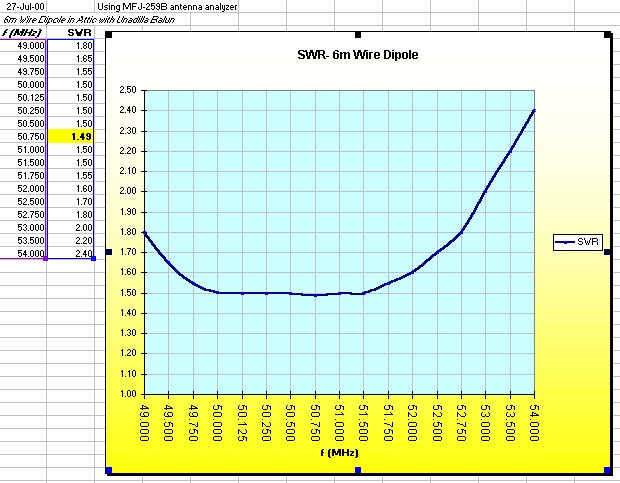
I used stranded Copperweld wire because I was originally going to hang it outside between trees. I still might. Copperweld is heavy copper plate over steel and is strong enough to prevent the worst of the sagging that inevitably occurs. Supporting it from the center is a definite help.
The Unadilla W2DU VHF balun works for 30-250 MHz. It's nice to have a center support; the W2DU has an eyehook to hang it from. It's also nice to have pigtails to solder to. You slide your wire through the eye hooks on the sides of the balun, wrap it up securely, and then solder the pigtails to your wire. Now the electrical connections bear no weight.
Wire dipoles are not known for being broad-banded devices, but larger conductor diameter will help slightly. In my case, I definitely had to give up good SWR in about a third of the band. I chose to tune for a center frequency of 50.250 MHz. I spent a lot of time climbing up and down a ladder while tuning this antenna. See the plot below for the results of my efforts.
I'm in Southeastern Wisconsin, grid EN53. With this dipole in my attic of my 1-story house, I worked a gentleman in Halifax (FN84) and others in EM50, EM55, EM64, EM81, EM85, FM04, FM05, FM14, FM16, FN33, FN34, FN43, and EL29. And I thought that one was in the ocean! Ok, I admit, many of these contacts were during band openings and excellent conditions. But people with three or five element beams up 30 or 40 feet give me 58 and 59 reports when the band is open. The guy in FN84 was using a Par omni.
One last note: I've had mixed results with some MFJ equipment in the past, but anyone that makes their own antennae needs an MFJ-259B analyzer. It has at perhaps two dozen functions, but even if you only use the SWR feature and cable tester (and maybe the frequency counter) it's worth every penny.
